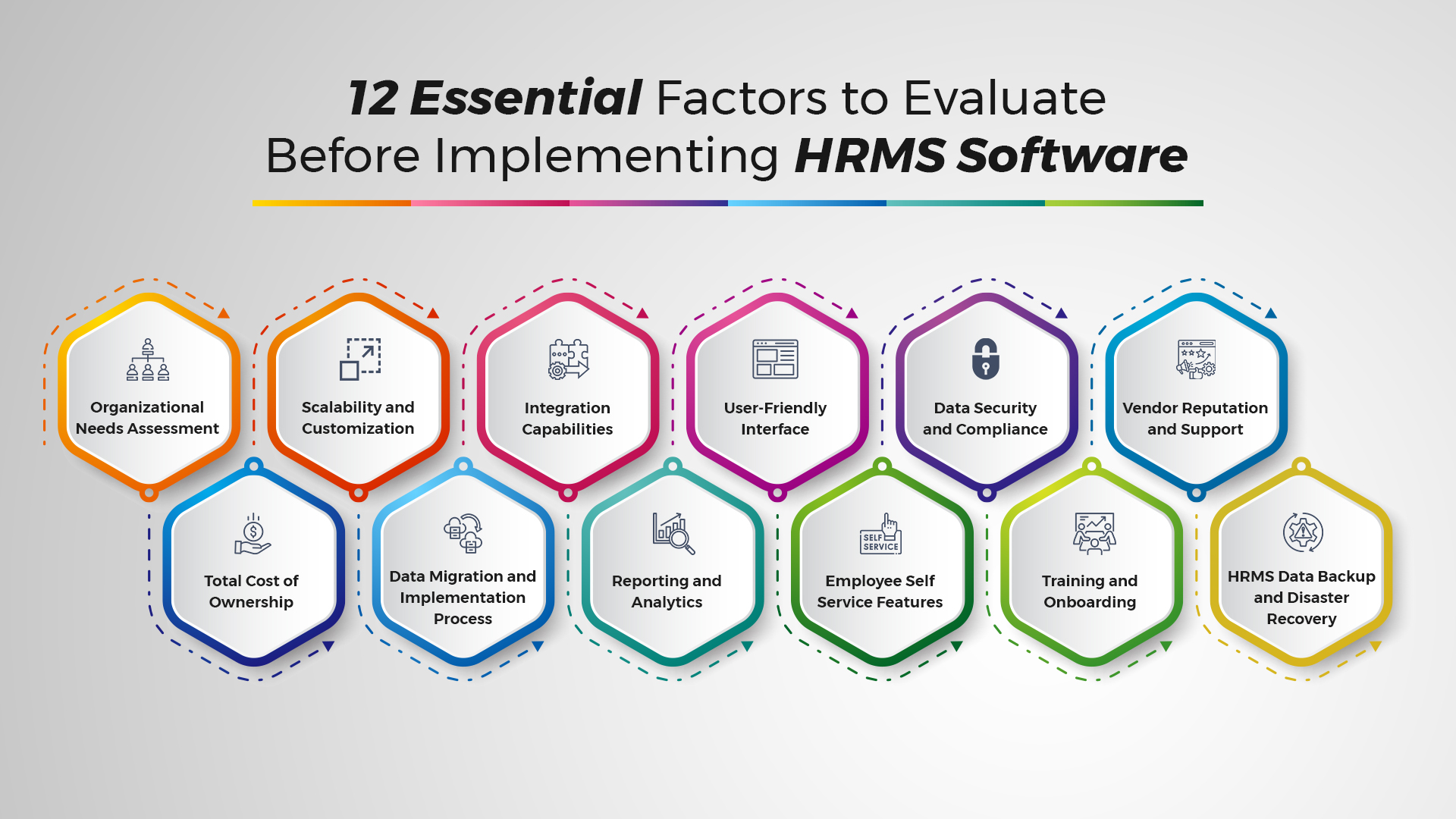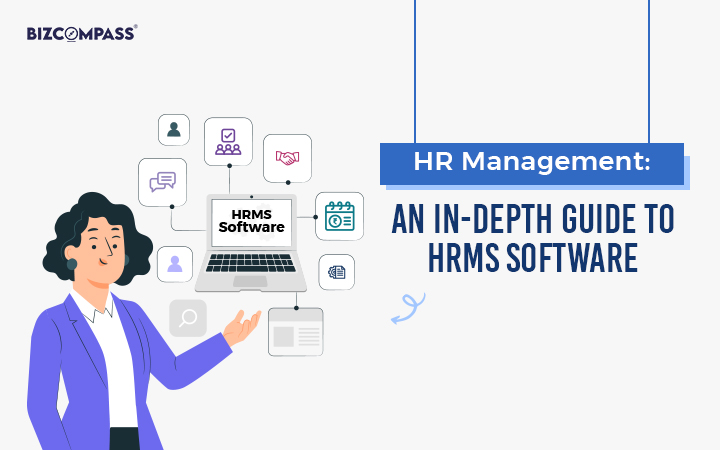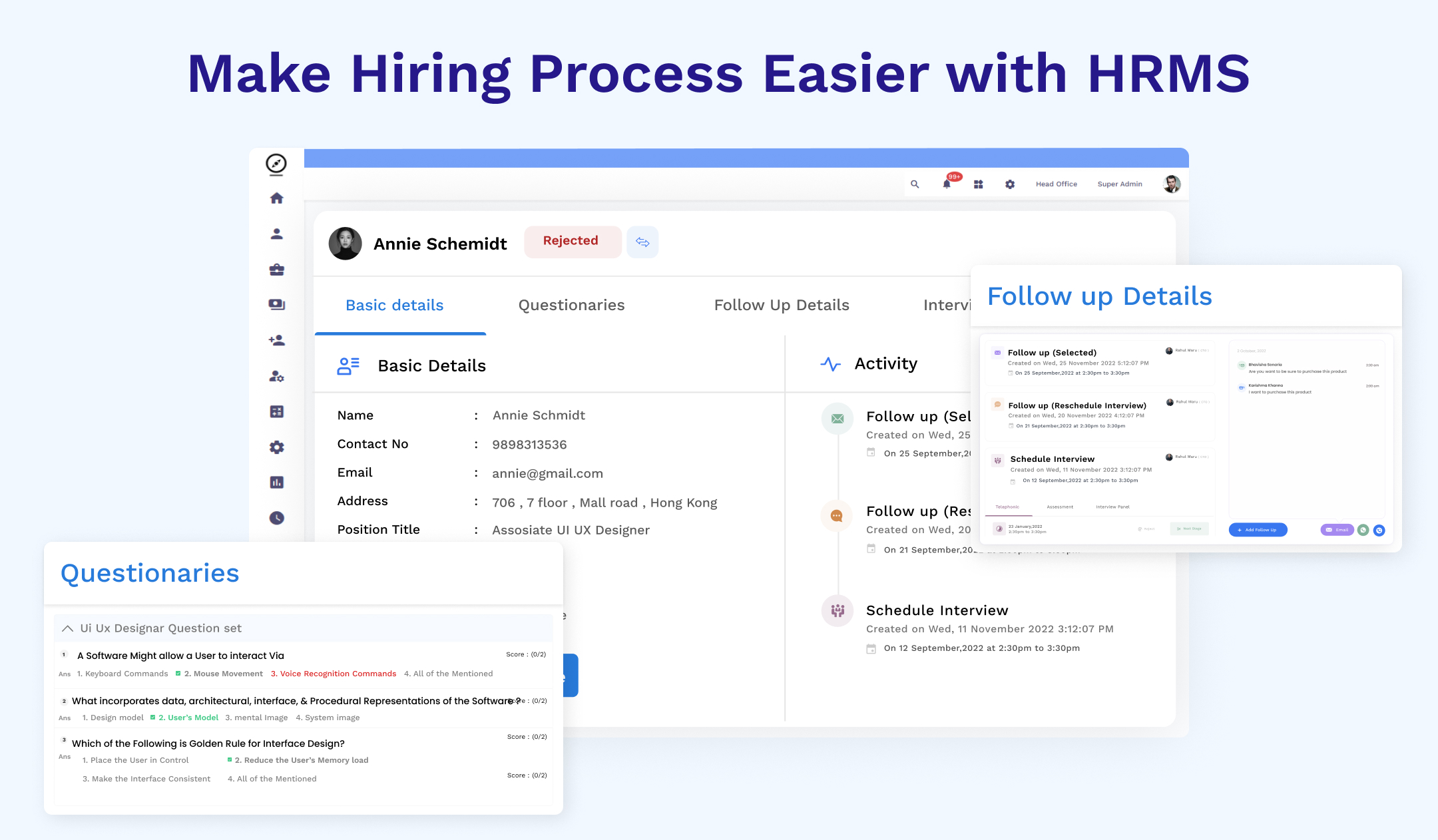Introduction
In today's fast-paced business environment, Human Resource Management Systems (HRMS) have become indispensable tools for managing workforce-related tasks efficiently.
Whether you are a small startup or a large corporation, implementing HRMS software can streamline HR processes, enhance productivity, and improve employee satisfaction.
However, before diving into the world of HRMS, it's crucial to evaluate various factors to ensure a successful implementation. In this comprehensive blog post, we'll delve into the 11 essential factors you should consider before implementing HRMS software.
Essential Factors To Evaluate Before Implementing HRMS Software
Organizational Needs Assessment
Before you give your business the power of HRMS, conduct a comprehensive assessment of your organizational needs so you can evaluate HRMS better. This involves:
Analyzing Current HR Processes and Pain Points: Take a close look at your existing HR processes, from recruitment and onboarding to performance management and payroll processing. Identify areas where inefficiencies, bottlenecks, or frustrations exist. Understand these pain points to address them effectively through HRMS implementation.
Identifying Goals and Objectives for HRMS Implementation: Determine what specific goals and objectives you aim to achieve with HRMS. Are you looking to improve employee data management, streamline the recruitment process, or enhance payroll processing accuracy? A clear understanding of your goals guides your HRMS selection and implementation strategy.
When You Evaluate HRMS Software, Scalability And Customization Options Are Crucial Considerations:
Evaluating HRMS Software Scalability for Future Growth: Assess the HRMS software's capacity to accommodate your company's growth without causing disruptions. Scalability ensures that your HRMS solution remains effective as your organization expands, allowing you to add new employees and features seamlessly.
Assessing Customization Options to Fit Unique Organizational Needs: Recognize that every organization has unique HR requirements and processes.
Therefore, it's essential to evaluate HRMS solutions that offer robust customization options. Look for software that can adapt to your specific needs, allowing you to tailor workflows, forms, and reports to align with your organizational nuances.
Seamless Integration With Existing Systems Is Essential:
Ensuring Seamless Integration with Existing Systems: Evaluate HRMS solutions for their ability to integrate smoothly with your current systems, such as payroll, time and attendance, or ERP software. Avoid data silos, redundant data entry, and information discrepancies by selecting an HRMS that can communicate effectively with your existing software solutions.
Compatibility with Other Software Solutions: Confirm that the HRMS software is compatible with your existing software stack. Compatibility issues can lead to operational inefficiencies, data inconsistencies, and increased IT complexity. A compatible HRMS ensures a cohesive and efficient software ecosystem.
User Adoption Hinges On A User-Friendly Interface, When You Evaluate HRMS Solutions:
Understand the importance of Intuitive User Interface: A user-friendly interface is paramount for successful HRMS adoption across your organization. Employees should find it easy to navigate the software without extensive training. An intuitive design reduces the learning curve and encourages users to embrace the HRMS as a valuable tool.
Consider Mobile-Friendliness and Remote Access: In today's remote work environment, mobile accessibility is crucial. Evaluate HRMS solutions for their compatibility with mobile devices and their ability to provide secure and user-friendly remote access to essential HR functions. Mobile access empowers remote and field-based employees to interact with HR.
Discussing Data Security Measures and Encryption: Data security is paramount when evaluating HRMS solutions. As you evaluate HRMS solutions, ensure that the software offers robust data security features, including data encryption, access controls, and data protection protocols. Protection against data breaches and unauthorized access is critical.
Ensuring Compliance with GDPR, HIPAA, and Other Regulations: Different industries and regions may have specific data protection and privacy regulations. When evaluating HRMS, confirm that the software complies with relevant laws, such as GDPR, HIPAA, and other regional data protection regulations. Compliance helps you avoid legal consequences and maintain your organization's reputation.
While You Evaluate The HRMS Solution, Choosing A Reputable Vendor With Reliable Support Is A Must:
Researching Vendor's Track Record and Reputation: Take the time to research HRMS vendors thoroughly. Read customer reviews, seek referrals, and assess the vendor's track record in delivering quality HRMS solutions. A vendor with a history of successful implementations and satisfied clients is a strong indicator of reliability.
Availability of Technical Support and Training: Technical support and training are integral to a smooth HRMS implementation. Evaluate the vendor's commitment to customer support by examining the availability of technical support channels, response times, and service-level agreements. Additionally, consider the availability of comprehensive training resources, including documentation, webinars, and on-site training options.
Total Cost Of Ownership (TC)
Evaluate the HRMS solution based on the total cost of ownership:
Initial Costs, Licensing Fees, and Implementation Expenses: Assess both the upfront costs and ongoing licensing fees associated with the HRMS solution. Consider the expenses related to implementation, including customization, data migration, and any hardware or infrastructure upgrades required for seamless integration.
Long-Term Maintenance and Upgrades Consideration: To manage your budget effectively, look beyond initial costs. Consider the long-term maintenance costs, including software updates, technical support contracts, and system enhancements. Understanding the full scope of TCO helps you plan and allocate resources appropriately.
Data Migration And Implementation Process
When you evaluate HRMS solutions, make sure you plan for a smooth transition:
Planning for Smooth Data Migration from Legacy Systems: Data migration is a critical aspect of HRMS implementation. Ensure that the HRMS solution includes a well-defined data migration plan. The transition from legacy systems should be seamless, minimizing data loss, inconsistencies, and disruptions in HR operations.
Understanding Implementation Timeline and Process: Gain a clear understanding of the HRMS implementation timeline and process. Define milestones, roles, and responsibilities to keep the project on track. Understanding the implementation process helps you set realistic expectations and ensures that all stakeholders are aligned.
Reporting And Analytics
Access to robust reporting and analytics tools is essential.
Exploring Reporting Capabilities for Informed Decision-Making: Evaluate HRMS solutions based on their reporting capabilities. The software should provide valuable insights into HR metrics, enabling informed decision-making. Look for features such as customizable reports, graphical dashboards, and the ability to drill down into data for deeper analysis.
Customizable Dashboards and Analytics Tools: Tailoring reports to your organization's specific needs enhances the value of the HRMS. Consider HRMS solutions that offer customizable dashboards and analytics tools, allowing you to create, save, and share reports tailored to different user roles and requirements.
Employee Self-Service Features
Consider the benefits of employee self-service:
Assessing Employee Access to Personal Information and Documents: Empowering employees to access their personal information and documents through the HRMS fosters engagement and self-sufficiency. Evaluate HRMS solutions for user-friendly self-service features that enable employees to view and update personal information, access pay stubs, and manage time-off requests conveniently.
Employee Self-Service Portal Benefits: Recognize the advantages of an employee self-service portal. This feature reduces administrative burdens on HR teams by allowing employees to independently perform HR-related tasks. It enhances employee satisfaction and frees HR staff to focus on strategic initiatives.
Training And Onboarding
Look for resources that facilitate user adoption:
Availability of Training Resources for Users: Effective training is essential for successful HRMS adoption. Evaluate HRMS solutions based on the availability of comprehensive training resources for users. Adequate training ensures that your team can effectively utilize the software and maximize its benefits.
User-Friendly Onboarding Process: A user-friendly onboarding process within the HRMS simplifies the introduction of the software to new users. A well-structured onboarding process minimizes resistance to change and accelerates user adoption. Consider HRMS solutions that provide step-by-step guides, video tutorials, and interactive onboarding modules to familiarize users with the system.
HRMS Data Backup And Disaster Recovery
Evaluate the HRMS software's data backup and disaster recovery capabilities, including:
Data Backup Procedures: Assess how the HRMS handles regular data backups to prevent data loss in case of system failures or other incidents.
Disaster Recovery Plans: Examine the existence of disaster recovery plans and procedures to ensure business continuity in case of unexpected events.
- Data Redundancy: Evaluate whether the HRMS stores data redundantly in secure locations to mitigate the risk of data loss.
Conclusion
Choosing and implementing HRMS software is a significant decision for any organization. By thoroughly evaluating these 11 essential factors, you can ensure that your HRMS implementation aligns with your organization's goals, leading to improved HR efficiency, data security, and employee satisfaction. Make an informed choice, and your HR department will thank you for it.
Remember, the right HRMS software isn't just a tool; it's a strategic investment in your organization's future success. Looking for the perfect HRMS solution for your business, Connect with Us.

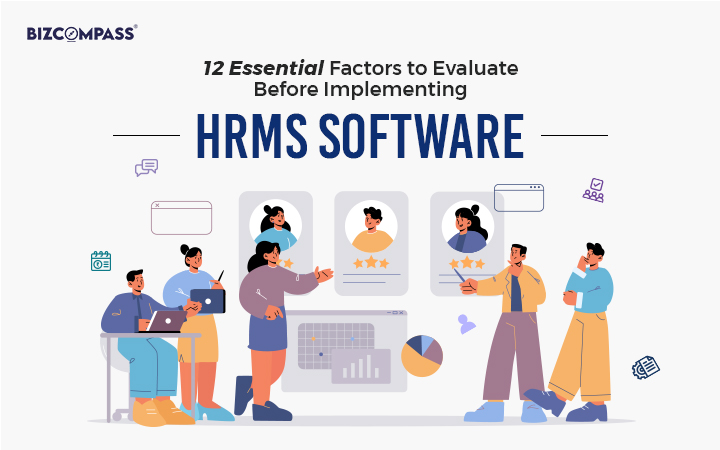
 >
>
